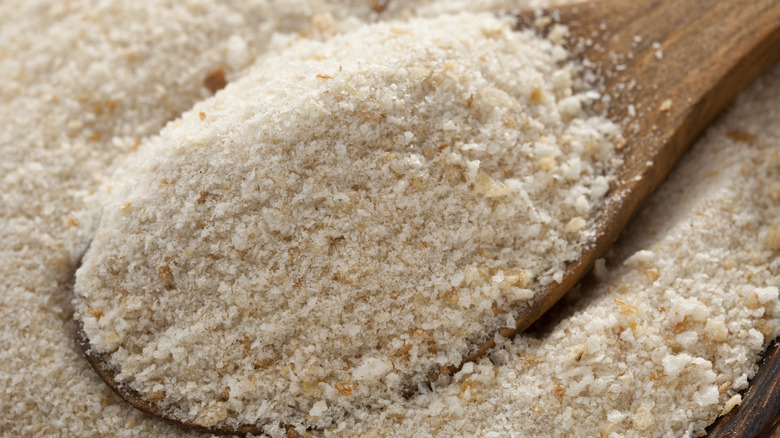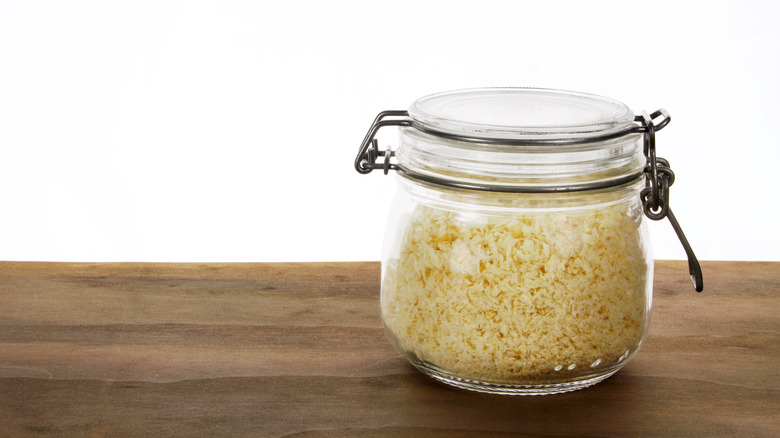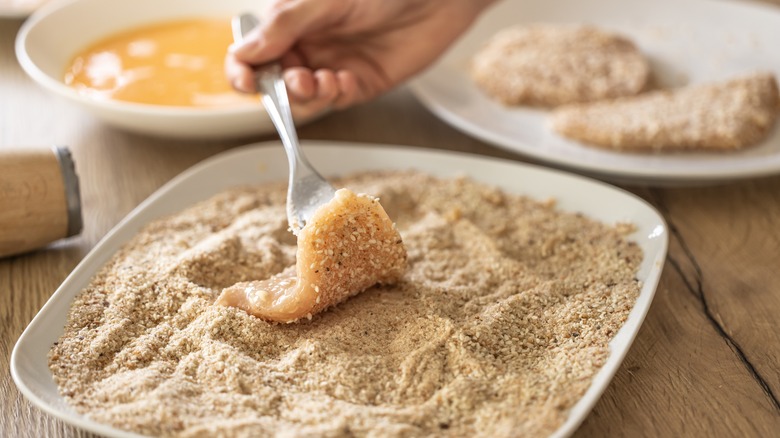How To Tell If Those Old Breadcrumbs Have Finally Gone Bad
If you're like most home cooks, there are probably going to be a few regular figures hanging around your pantry for a long, long time — we're talking months, if not years. In some cases, like with white vinegar, those items are still good to use basically forever. But in most cases, even with so-called "non-perishables," it's a good idea to consult the expiration or "best by" date printed on the packaging. Store-bought breadcrumbs are no exception, which may come as a surprise to you.
It's true that breadcrumbs aren't nearly as perishable as fresh bread, because they've been dried out. Since their moisture has been removed, they won't get moldy within a week or so like actual bread tends to. They will, however, become stale over time. Depending on what you're making, this can affect how your recipes come out. For this reason, it's recommended to keep breadcrumbs for no more than six months after opening, or if unopened, let the package hang out in your pantry for no more than a year.
Stale breadcrumbs are unlikely to make you sick, but they'll contribute less flavor and a mealier, grittier texture than they would if they were fresher. But if you open up the package and see mold, wet clumps, bugs, or they smell sour or otherwise off, it's a different story. In those cases, toss them immediately in the interest of safety.
From young to mold
The best way to keep breadcrumbs from going rancid is by keeping them away from any source of moisture, safely sealed in an airtight container kept somewhere away from heat (i.e., a pantry cabinet that's not immediately adjacent to the oven). This way, they're protected from mold-causing moisture and any extraneous bacteria that may be harmful if consumed, as well as heat and light, which can make them go stale more quickly.
All of this goes for store-bought dried, pantry-safe breadcrumbs, of course; fresh breadcrumbs, made at home, generally last a maximum of five days, refrigerated. If you've toasted your breadcrumbs, they have about a month in the pantry.
You can also freeze both fresh and dried breadcrumbs, homemade or store-bought, if you have a whole lot on your hands and want to make sure they last. In both cases, just keep them in airtight, freezer-safe containers. They'll be good in there for up to six months, so be sure to write the date on whatever container you use so you can keep track. When you're ready to use them, you can let them defrost in the fridge, or let them sit out on the counter at room temperature. Just don't leave them sitting for more than half an hour to an hour before using them, or bacteria can start to grow.
The breadcrumb trail has gone stale
If your breadcrumbs aren't showing any signs of mold or spoilage, they're just stiffer, drier, and less flavorful than they once were, they're probably not unsafe to eat. They might not get as crispy as they once would have, so if you're making a dish that really counts on that crispiness — like anything you're going to bread and fry, or anywhere they're meant to be a delicately crunchy garnish — you might end up disappointed if you use stale breadcrumbs. But if the breadcrumbs are just meant to add bulk and a bit of starchiness, like in stews and sauces, or meatballs and meatloaf, they'll get the job done.
All of that said, if you're ever looking at a package of breadcrumbs that's passed its expiration or "best by" date and you're just not sure if they look or smell off or not, err on the side of caution and toss them. It's great to avoid waste whenever possible, but not at risk of making yourself sick. Fortunately, breadcrumbs are easy to make and cheap to buy, so it's not a huge loss.


